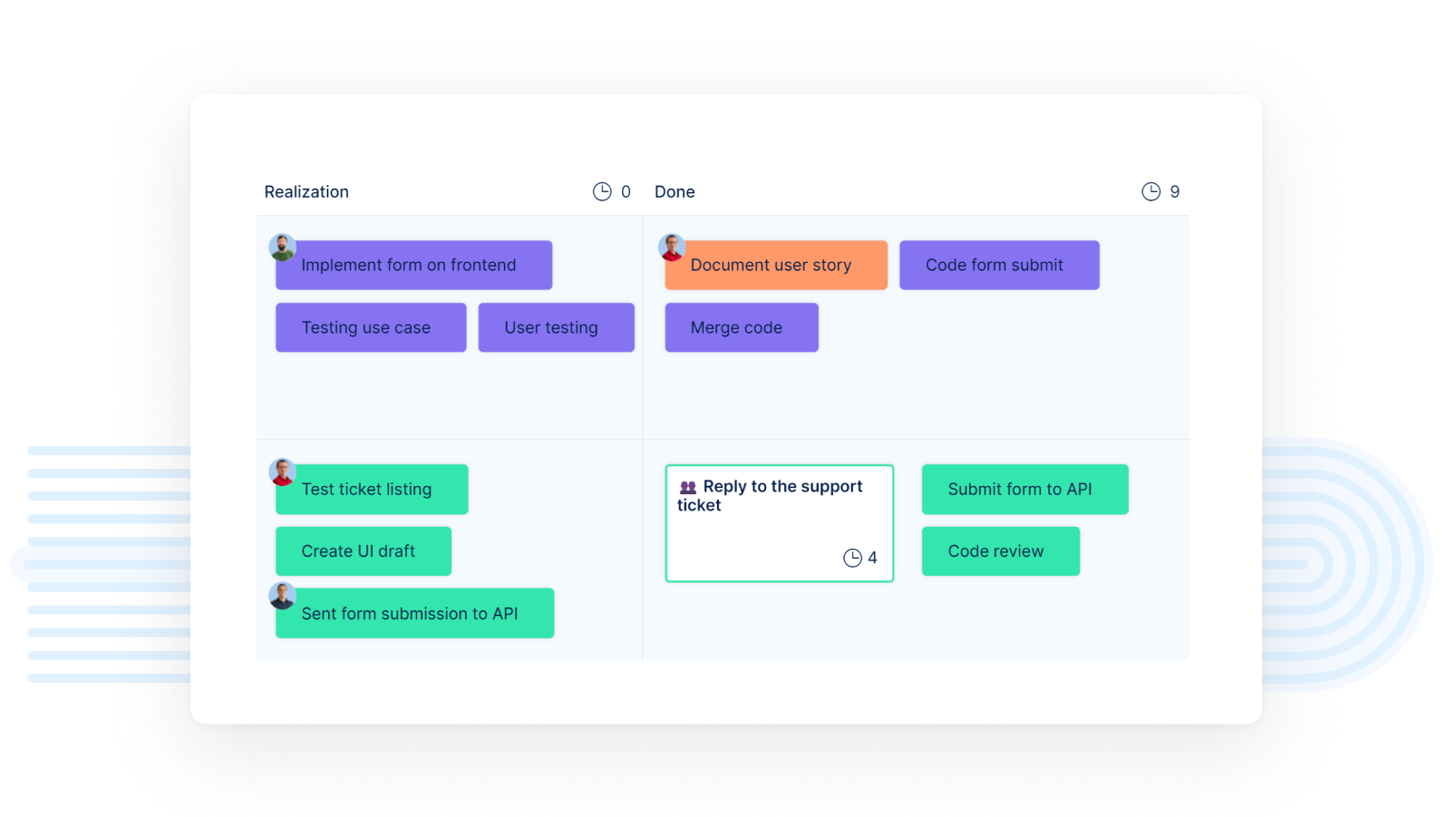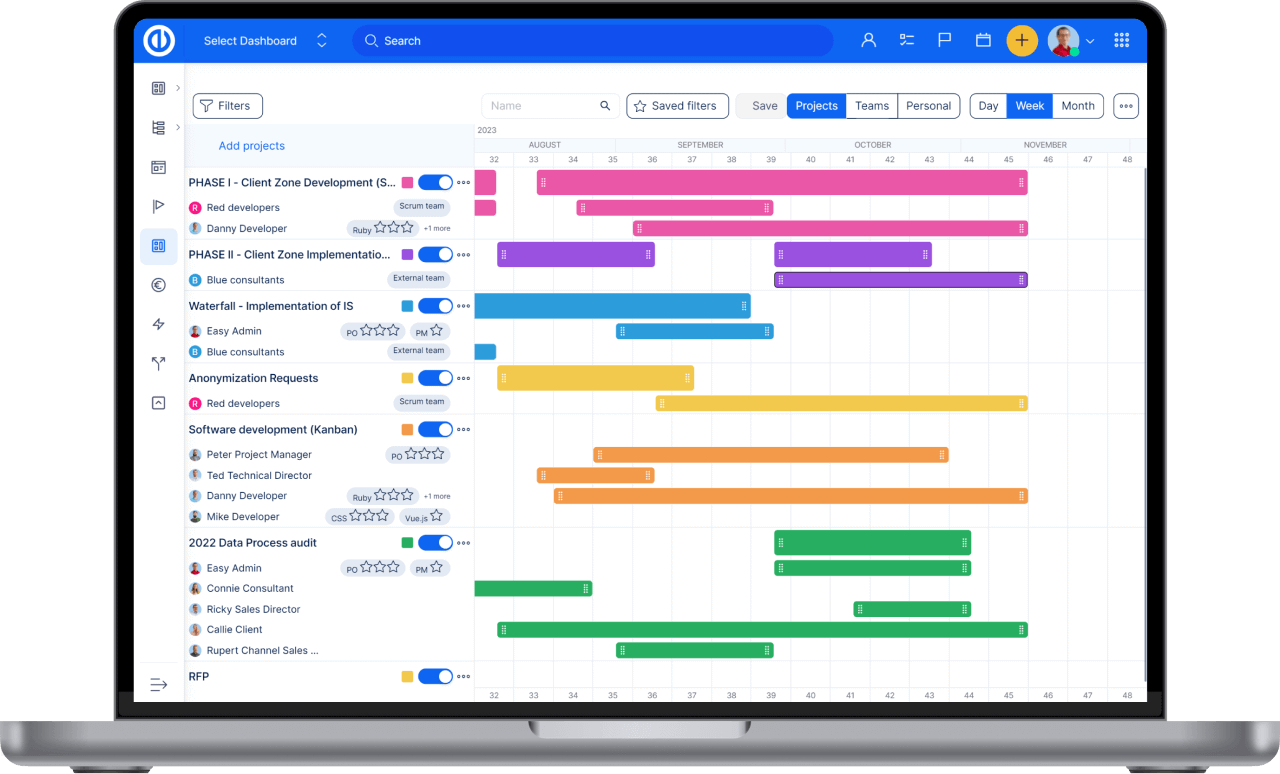Revolutionizing Scrum Workflows: Real user insights into Easy Redmine 13 Scrum Boards
In software development, real-world challenges guide the best innovations. There’s nothing like firsthand experience to steer the product in the right direction. Our Scrum Boards in Easy Redmine 13 reflect this principle. Our team’s challenges, needs, and day-to-day scenarios have shaped them, improved them and helped to streamline their functionality.

Scrum, as a framework, affects various team roles, each contributing uniquely to the project's success.
Recognizing this diversity, it's crucial that any tool aiming to assist in Scrum must cater to these distinct roles and their specific needs. To better understand this multifaceted relationship, we sat down with three members of our own team, each representing different roles: Matúš, Anita, and Jan.
Our objective was to delve into their past experiences, discern what they previously used, and gauge their sentiments about our new Scrum boards. Dive into the stories of Matúš, Anita, and Jan, and discover the transformation these boards brought to their workflow!
"Refinements are more enjoyable", Matúš said
Matúš, a dedicated Frontend Web Developer, has spent the past two years at Easy Software, focusing on developing Easy Redmine’s UI.
His previous career trajectory also saw him in Älmhult, Sweden, for a two-year stint with IKEA Components A.B.
Here, his primary responsibility was process development, where he channelled his skills to design and implement processes aimed at bolstering efficiency. For someone who has coordinated complex IT systems at this scale, Matúš has seen it all. External vendors, drawn-out meetings, and misaligned communication were his daily adversaries…
Hi, Matúš! Can you shed some light on your Scrum experience prior to Easy Software and how it was, even in other companies?
Matúš: At Easy, I've been for 2 years, mainly working with older Scrum Boards. In other companies, we primarily used Jira.
How would you describe your day-to-day work using Scrum Boards?
Matúš: I mostly implement. For me, it’s always open as a tab, providing real-time updates. Unlike other platforms where tasks are thrown around, here, colleagues call each other, open the board, and discuss. This really brings teams closer. I prefer instant discussions. It's different from overwhelmed corporations. I can instantly see if teammates added new tasks. Collaborating with a colleague is quick. Active engagement with the board is crucial for its effective use. Efficient teams get more out of it. It offers a clear view of the team’s performance, allowing one to step beyond their specialization. We've adopted new technologies like the new Vue, and the new Graph. Immediate change visibility, a new UI. Our tech stack for '22/'23 matches standards in the US, or even Google.
What benefits do Scrum Boards bring to your work?
Matúš: Transparency from start to finish. Refinements have become more enjoyable and simpler. I probably attend fewer meetings and do more coding. And I use colors/emoticons for task evaluations. During the summer, I work from Morava, always in tune with the team's vibe. It’s excellent for newcomers. Our developer team is like a band; one leads while others discuss. It's easier for a newbie to absorb.
What are your favorite features?
Matúš: The transparency of the work process, from beginning to end. I look forward to refinements; they're simpler now. I probably attend fewer meetings and do more coding. I use colors/emoticons for task evaluations. Currently working from Morava over the summer, I always feel in sync with the team's vibe. It’s super user-friendly for newcomers. Our dev team operates like a band, with a leading speaker. For a new person, the learning curve is smoother. However, one must be careful of antipatterns like PBIs appearing twice or poorly written PBIs that remain static.
Any improvements you'd suggest for Scrum Boards?
Matúš: I've been using it daily for half a year now. The next step I'd like to see is integration with Git, bulk edits, and more automation.
From a Scrum Master's perspective, how was the implementation of Scrum Boards in terms of changing the team’s mindset?
Matúš: I can't speak from a Scrum Master's perspective, but from what I observe, while the technical integration was one aspect, shifting the team's mindset was equally pivotal.

Scrum Boards
Anita: "It's particularly beneficial for new members to grasp our workflow quickly."
Anita has cultivated an extensive background in agile methodologies, honed through roles in various reputed companies such as Seznam or Vodafone.
For nearly two years at Easy Software, Anita embraced the role of an Agile Master, advocating for a culture of constant improvement and learning.
She fervently supports the mission of enhancing company-wide efficiency through retrospectives, ensuring every team member has clarity on his tasks, and fosters a structure where teams can operate autonomously with a clear sense of responsibility…
Hi, Anita! Can you share a brief overview of your Scrum journey before joining the company?
Anita: Sure, I was a Scrum Master at Vodafone for some time. There, I managed multiple development teams, each having its unique challenges. I also had the opportunity to work at Seznam.cz, which further honed my skills as a Scrum Master, guiding both newcomers and those seeking advanced agile knowledge.
Interviewer: How would you describe your day-to-day role and responsibilities using Scrum Boards?
Anita: On a daily basis, Scrum Boards help me stay updated in real-time. It's more than just a tool; it brings my teams closer. We discuss tasks immediately, which fosters collaboration and transparency. It allows me to gauge our performance and make necessary adjustments for efficiency.
Interviewer: What are some standout features or aspects of the Scrum Boards that you value most?
Anita: I appreciate the transparency Scrum Boards offers, from project inception to completion. The immediate feedback loops and visual aids, like emoticons and color codes, make evaluations straightforward. It's particularly beneficial for new members to grasp our workflow quickly.
Interviewer: Given your extensive experience, are there any enhancements you'd recommend for the Scrum Boards?
Anita: While Scrum Boards have been immensely helpful, I believe integration with other platforms, like Git, and features that allow bulk edits could be game-changers.
Interviewer: Finally, from a Scrum Master's viewpoint, how challenging or rewarding was it to instill the Scrum mindset into your teams?
Anita: It's always a balance. Technically implementing Scrum is one thing, but shaping the team's mindset is the real challenge. However, seeing a team fully embrace and thrive using Scrum is immensely rewarding.
Jan: "Our backlog isn't overwhelmed anymore."
Jan boasts an impressive professional trajectory with Easy Software Ltd., where he has served in various pivotal roles over a span of more than seven years.
Commencing his journey as a Consultant in Prague offices, he dedicated himself to configuring and imparting training on Easy Redmine, enhancing the overall product experience. which elevated him to the position of Head of Consulting.
Since January 2021, Jan has been leading as the Head of the Project Management Office, making commendable strides to streamline processes and improve user interactions.
Recently, Jan has also undertaken the mantle of a Product Owner, because of his deep knowledge of the product…
Hi, Jan! Can you start by telling us about your previous Scrum experiences, perhaps even from different companies?
Jan: Of course. Previously, we used older boards which had many columns. There was a lot of siloed work and frustration, especially in the 'testing' phase. The columns seemed disproportionate, leading to a misconception that we needed more testers. Classic situations like 'on client' and 'testing' added to the imbalance in workload distribution among the team.
How would you describe your daily tasks using the new Scrum Boards now?
Jan: Before, we had to constantly probe developers for information, often facing uncomfortable silences. Now, our team communicates more directly, and many have taken leadership roles in meetings. Earlier, we used easy project tasks which, despite having small forms, still required custom field fill-ins. One had to constantly remember the organization of the backlog.
How have new Scrum Boards assisted in your work?
Jan: Greatly! Our backlog isn't overwhelmed anymore. We don't need to deal with unnecessary tasks or repeat past mistakes. With older boards, I felt buried and prioritization was a challenge. Now, the sequencing feature has eliminated that struggle.
Lastly, what are your favorite features of the current Scrum Boards?
Jan: I am really happy about it. It's a significant improvement over the old boards. I'm genuinely happy with the release and eagerly await user feedback!
Conclusion
Tools are only as effective as the real-world problems they address. Easy Redmine 13’s Scrum Boards emerged from the crucible of genuine challenges faced by teams on a daily basis.
Scrum Boards in Easy Redmine 13 are not only streamlining workflows but also fostering collaboration, transparency, and efficiency.
Want to learn more about Easy Redmine 13 Scrum Boards? Head here.

All-in-one software for a modern project manager? Easy.
Get all powerful tools for perfect project planning, management, and control in one software.
